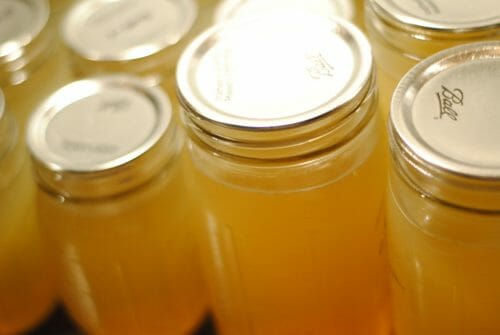Pressure cooking chicken stock is a great reason to love pressure cookers. Many reviews speak highly of electric pressure cookers like the Instant-Pot Pressure Cooker because you don’t have to monitor the pot for hours, add lot’s of water, or keep stirring the pot.
Ten Essential Ingredients For Chicken Stock
- Chicken
- Onions
- Celery
- Carrots
- Bay leaves
- Peppercorn
- Garlic
- Herbs
- Cider
- Water

Using a Pressure Cooker
Using a pressure cooker is not scary, like the one’s back in the old days. They make better meals, in a fast manner, provide less energy, and preserve nutrients. The InstantPot has a 12-key function for all cooking duties, quiet, and is UL/ULC certified (just one of several good options). It also has awesome features and comes with an easy to read manual.
A harried dinner prep at the end of a long day welcomes a pressure cooker. It’s a great investment that can save a person long hours of standing in front of a stove, hanging out in the kitchen, and trying to plan out what to add to the main entrée.
There are many other reasons to embrace a pressure cooker over other traditional options. Some people do not like to deal with heat issues, the duplicate functions of slow cookers, have limited kitchen space, or worry about burning food. Most electric pressure cookers allow scheduling and delayed start for up to 12 hours, depending on the model.
While your chicken stock is cooking, the pressure created by boiling water allows the temperature to rise, and all the nutrients are preserved. After you finish cooking your stock, there are three ways to release pressure. You can try the quick release, natural release, or the cold water release, which require running cold tap water over the edge of the pressure cooker’s lid.
There are many advantages and disadvantages of a pressure cooker. The good news is that less water is required than conventional boiling, several foods can be cooked together, and you can use a term called Maillard reaction– for more flavor.
Directions To Get Started
- Chop the bones up into coarse chunks
- Place them into the cooker
- Add vegetables and spices according to your preference or availability (no strict rules but root vegetables are great)
- Add liquid to cover but don’t exceed the fill line
- Secure the lid, and set the cooker at a high-pressure temperature for 25 minutes, then allow time for the natural release process. For later use, you can place a 2-layered cheese cloth
- Allow time for the release process
- Strain the liquid over a large bowl
- Place in the refrigerator
- After 6-8 hours skim the solidified fat off the surface and discard.
- Ladle the stock into labeled freezer-safe, quart-size, zip-top bags for later use
Wrap-Up
This is a simple way to enjoy chicken stock to add flavor to any meal. Homemade chicken stock has richer flavor than anything you can buy in a store.
Ultimately, pressure cookers save energy and time to while you have the luxury of doing other things as your chicken stock cooks.
Leave a Reply